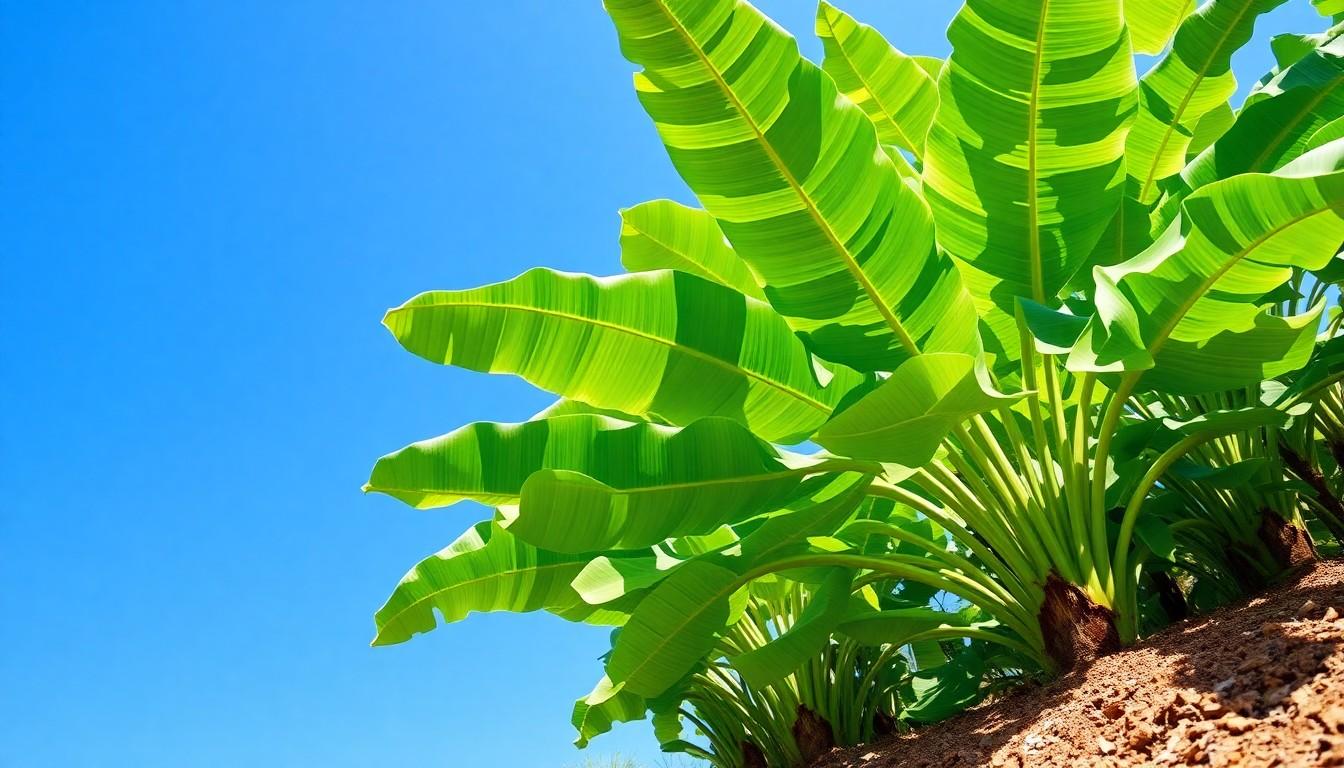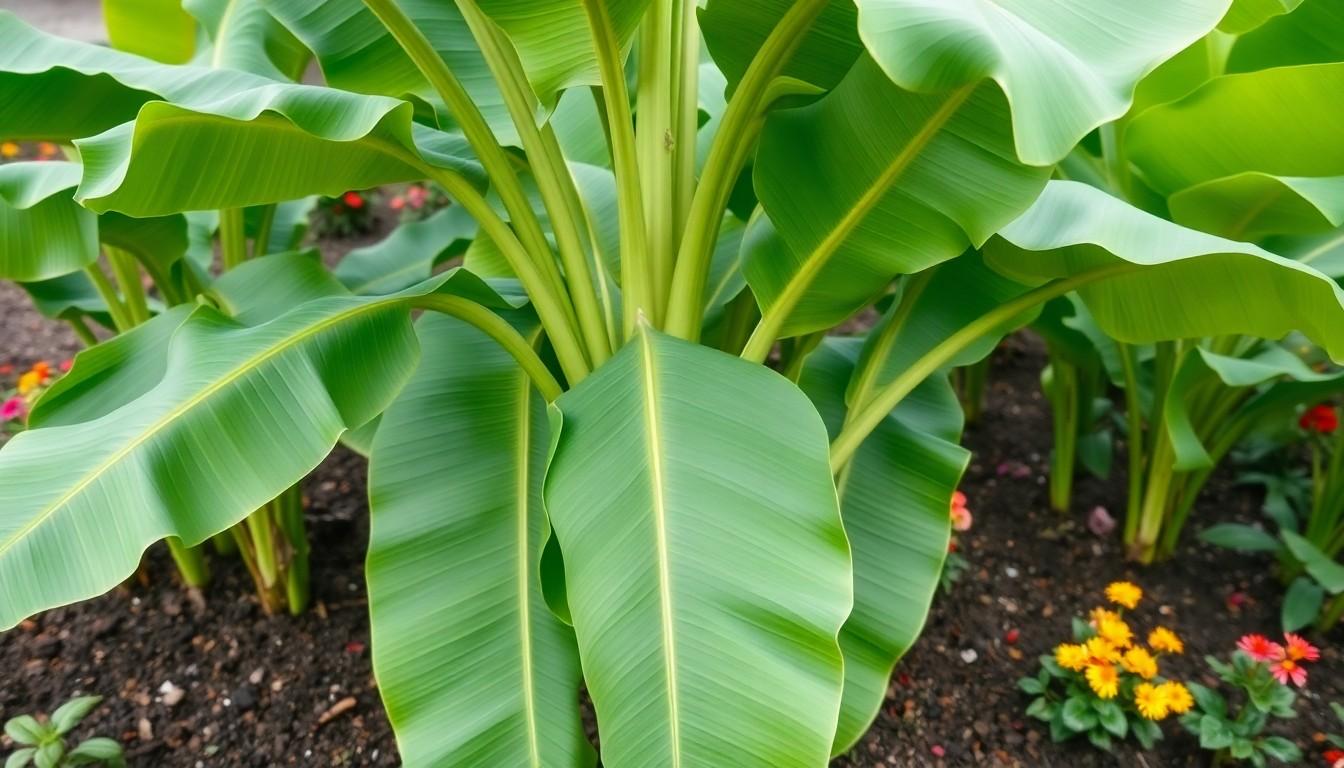Imagine a world where your garden boasts vibrant, tropical vibes without the need for a plane ticket. Enter the hardy banana plant—a true showstopper that can thrive in cooler climates. With its broad leaves and cheerful demeanor, this green giant isn’t just a pretty face; it’s also surprisingly easy to care for.
Hardy Banana Plant Care
Hardy banana plants thrive in a variety of climates, particularly in cooler areas where traditional banana varieties struggle. Broad leaves provide a lush, tropical appearance, making them popular choices for landscapes and gardens. These plants can reach heights of 6 to 10 feet depending on the specific variety and growing conditions.
Several hardy varieties, such as the “Basjoo,” exhibit exceptional cold tolerance. Cold-hardy bananas can withstand temperatures as low as -10°F. Growth occurs rapidly during the warmer months, usually from late spring through early fall.
Fruits from hardy banana plants, while not always produced in colder climates, can develop under ideal conditions. Planting in well-draining soil ensures roots don’t become waterlogged, promoting healthy growth. Regular watering supports optimal leaf development, especially during peak growing seasons.
Fertilization enhances growth, typically requiring balanced fertilizers throughout the growing period. Pests and diseases pose minimal risks, though occasional issues like aphids and spider mites may occur. Implementing organic pest control methods can mitigate these challenges effectively.
Pruning dead leaves and spent flower stalks maintains an attractive appearance and encourages new growth. Mulching around the base protects roots during colder months. Overall, hardy banana plants offer beauty and resilience, making them excellent choices for diverse gardening environments.
Ideal Growing Conditions
Hardy banana plants thrive best under specific conditions that ensure their optimal growth. Understanding soil and sunlight needs is essential for cultivating healthy plants.
Soil Requirements
Well-draining soil is crucial for hardy banana plants. Sandy loam or loamy soil provides excellent drainage while retaining moisture. Nutrient-rich soil enhances the growth and health of the plant. Soil pH should range from 5.5 to 7.0, promoting nutrient availability. Regularly incorporating organic matter helps maintain soil fertility. Mulching around the base retains moisture and suppresses weeds, contributing to a healthy root system. Ensuring proper drainage prevents waterlogging, which could damage the roots over time.
Sunlight Exposure
Full sun exposure is ideal for hardy banana plants. At least six hours of direct sunlight promotes vigorous growth and vibrant foliage. While they can tolerate partial shade, insufficient light may hinder fruit development. Positioning the plant in a bright location enhances its resilience against cold temperatures. During extreme heat, some afternoon shade provides relief from scorching sun. Understanding local climate conditions can help optimize light exposure as well. Investing in proper placement results in healthier plants that thrive throughout the growing season.
Watering And Fertilization
Proper watering and fertilization play crucial roles in hardy banana plant care. These plants thrive best when given adequate moisture and nutrients.
Watering Techniques
Watering hardy banana plants requires attention and consistency. Deep watering is essential, ensuring moisture reaches the root zone. Drip irrigation or soaker hoses work well, minimizing water waste. Regular watering maintains soil moisture without causing waterlogging, which can harm roots. During dry spells, checking the soil moisture is important; if it’s dry to the touch, it’s time to water. In cooler months, reduce watering frequency to prevent root rot.
Best Fertilizers For Hardy Bananas
Selecting the right fertilizers greatly impacts the health of hardy banana plants. Balanced fertilizers with an N-P-K ratio of 10-10-10 promote vigorous growth, while slow-release options provide steady nutrition. Organic fertilizers like compost or aged manure boost soil health and improve water retention. In spring, applying fertilizer helps support new growth; a second application mid-summer can enhance foliage development. Always follow package instructions for application rates to avoid over-fertilization.
Pruning And Maintenance
Pruning plays a crucial role in maintaining the health and appearance of hardy banana plants. Regular maintenance ensures optimal growth and enhances the plant’s overall resilience.
When To Prune
Pruning should take place in early spring before new growth starts. Timing is essential, as it allows for better recovery and encourages lush foliage. Inspect the plant for any dead or damaged leaves, as these should be removed promptly. Regularly monitoring the plant throughout the growing season provides opportunities to manage its size and shape. If necessary, additional light pruning can occur in late summer.
How To Prune Effectively
Effective pruning techniques promote healthy growth and establish a well-shaped banana plant. Use clean, sharp shears for precise cuts, and make cuts at an angle to enhance healing. Focus on removing any yellowing or brown leaves first, as this promotes aesthetic appeal. Thinning out dense areas improves air circulation, which reduces the risk of disease. When cutting back to the base, leave a few healthy stems to support new growth. Regularly cleaning shears between cuts prevents the spread of disease.
Common Pests And Diseases
Hardy banana plants face several potential pests and diseases, making vigilance important for maintaining their health. Identifying these threats early can prevent serious damage.
Identification And Prevention
Common pests include aphids, spider mites, and banana weevils. Aphids appear as small, green or black insects clustered on leaves. Spider mites often produce fine webs on the undersides of foliage. Banana weevils cause leaf curling and yellowing as they burrow into stems. To prevent infestations, regularly inspect plants for signs of distress. Maintaining cleanliness around the garden and removing debris can deter pests. Introducing beneficial insects like ladybugs can help manage aphid populations effectively. Additionally, ensuring good air circulation inhibits fungal diseases, as damp conditions promote growth.
Treatment Options
For aphid infestations, spraying plants with a strong stream of water can dislodge them. Insecticidal soap provides a safe treatment option for sensitive plants. Spider mites respond well to applications of neem oil or horticultural oil, which suffocates them. For banana weevils, wrapping the base of the plant with sticky traps captures adult insects. Cultural practices, like proper watering, reduce stress on the plant, making it less susceptible to pests. In severe cases, systemic insecticides may be necessary, but application instructions require strict adherence to avoid harm to beneficial organisms.
Stunning Appearance and Resilience
Caring for hardy banana plants offers gardeners a rewarding experience with their stunning appearance and resilience. By focusing on essential practices like proper watering, fertilization, and pruning, these plants can thrive even in challenging climates. Awareness of local weather conditions and potential pest threats further enhances their health and beauty.
With the right care, hardy banana plants can transform any garden into a vibrant oasis, showcasing their unique charm and adaptability. Embracing these techniques ensures that gardeners enjoy the lush foliage and potential fruiting of these remarkable plants for years to come.



